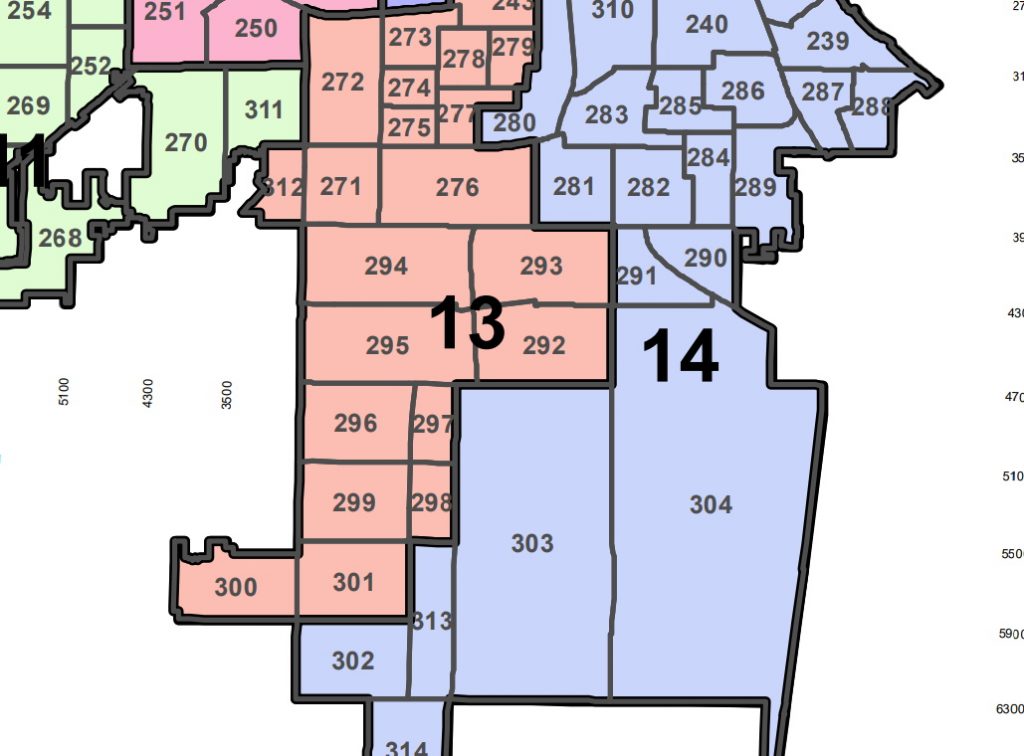Council Ends Redistricting With Anger, Tears
Council members call process unfair, unjust and infuriating. How did things go wrong?
The City of Milwaukee’s “warp speed” redistricting process ended where it started, but only after months of unexpected debate and a substantial number of city officials and community members expressing frustration.
“This is infuriating and absolutely disappointing,” said Alderwoman JoCasta Zamarripa on Tuesday to her council colleagues while fighting back tears.
The council then voted to re-adopt a map then-Mayor Tom Barrett vetoed in December.
It ended, at least for the council, a process that was delayed and then rushed because of issues at other levels of government, restarted after a mayoral veto and ultimately aborted after a City Attorney’s Office opinion was issued in closed session on Jan. 10.
At issue was the configuration of a handful of south-side districts. Latino community leaders, including Christine Neumann-Ortiz of Voces de la Frontera and Darryl Morin of Forward Latino, were calling for a third Hispanic-majority or near-majority district to be created to reflect the city’s growing Hispanic population.
“Colleagues, I want you to know what a slap in the face this redistricting process has been to Milwaukee’s Latino community,” said Zamarripa, the first female Latino council member in city history. “My community was dealt a huge blow, sucker punched by the City Attorney’s Office.”
“I don’t think this is the way we wanted our decision making to end, but I can safely say that I know all members attempted to engage the Hispanic community openly on their voting rights,” said Alderman Ashanti Hamilton, who led the redistricting process. “I think the way this ended up was an unfair process with all of the surprises.”
Getting to the frustrating finish line, should a lawsuit not emerge, involved lots of small steps that further limited options in subsequent steps.
On Nov. 17 the council unanimously adopted a map of 317 wards. The non-controversial map realigned wards that had grown too big or small as a result of the city losing 17,611 residents in the past decade. Each, under state law, must have between 1,000 and 4,000 residents. The new wards also addressed boundaries that were bisected when the county concluded its own controversial redistricting process.
By splitting the ward process from the redistricting process, the city was able to meet a state deadline to return its ward map to the county. But splitting the process also limited boundary line options when reconfiguring districts in the future.
During a Nov. 22 committee meeting, Ald. Scott Spiker and Legislative Reference Bureau representatives said they were unable to create a third majority Hispanic district given other constraints on the process, but had explored the idea. Spiker said regardless of adjustments to his far south-side district, he expected it to likely become majority Hispanic in the next decade.
When considering only the voting age population, the city is now 38.6% white, 36.1% Black, 17.6% Hispanic and 5.1% Asian. The Hispanic population grew in the past decade as the Black and white populations fell.
On Nov. 23 the full council voted 14-1 to adopt the proposed 15-district map, a second vote intended to meet a state deadline.
The map maintained the balance of six Black majority districts, two Hispanic districts and five white districts of which two are now being described as Hispanic “influence” districts. There is no legal definition for an “influence” district, but the council is informally defining it as a 25% voting bloc. Two districts have no racial or ethnic majority.
Zamarripa was the lone council member to vote against the council’s original map, but didn’t speak against it on the floor.
“I heard from community members… there were issues raised in particular with the Latino numbers and what that could mean for redistricting,” said Zamarripa in an interview. She said she agreed with the Legislative Reference Bureau’s assessment that drawing three-majority Hispanic districts would be difficult and said it was unfortunate that federal, state and county delays put the city in a tough spot.
Led by Voces de la Frontera, a high-profile lobbying effort began pushing Barrett to veto the maps and on Dec. 6 he did just that. He singled out concerns with the Hispanic representation in the two influence districts, Spiker’s 13th district and Marina Dimitrijevic‘s 14th district.
Barrett, citing a City Attorney opinion, said the council could wait until Jan 18. to adopt a new district map. The wards had to be completed earlier because they will be used for the upcoming county supervisory races, but the council districts won’t be used until the 2024 election.
Council Agrees To Restart
Despite the 14-1 vote to approve the map in the first place, the Common Council voted unanimously to sustain Barrett’s veto on Dec. 14 and halted the map’s implementation.
“I thank you from the bottom of my heart for simply listening,” said Zamarripa at the meeting.
“I think the process we are going through now is greater than redistricting,” said Hamilton. “This is something that we should do if we are given the extra time to do.”
Closed-Session Discussion Halts Redistricting Process
After a six-hour meeting on Jan. 10, which included four new map concepts being discussed and Latino and Muslim community leaders advocating for various proposals, a council committee ended up back where it was in November.
“We have received some advice that was surprising to some members,” said Ald. Robert Bauman after the committee emerged from a three-hour, closed-session discussion with the City Attorney’s Office.
At its simplest level, the City Attorney’s Office doesn’t believe any of the council’s revised maps would survive a 14th Amendment equal protection challenge in court. The council and community members’ explicit rationale for considering changes was race and, under the legal standard of strict scrutiny, the council could only consider race if it was correcting a federal Voting Rights Act violation. The City Attorney’s Office believes no such violation exists with the earlier map (Map A), but did previously provide Barrett advice on the legality of vetoing it and extending the process.
After the meeting, Voces executive director Christine Neumann-Ortiz called the committee’s actions a “disgrace” and “disappointing.” She said her organization is looking for its own legal opinion and considering further actions.
“We think there is a possibility that there is a voting rights violation,” said Voces redistricting commission member and attorney Richard Saks. “That’s something we’re going to explore.”
“If Latinos are 20% of the population that means they should be entitled to three aldermanic representatives,” said Neumann-Ortiz. She said Spiker, who has touted the diversity of his district, was attempting to maintain a district controlled by white conservatives.
“We created the compromise map, which is now known as B,” said Forward Latino head Darryl Morin during the meeting. It increased the Hispanic population in the 13th at the expense of the 14th.
But his proposal, and many others, split another community.
Centered around the Islamic Society of Milwaukee, 4704 S. 13th St., a growing Muslim community fills District 13. “The Muslim community very much lives in a circle around that,” said Palestinian immigrant and real estate developer Nabil Salous.
Though it was referred to by many speakers as a Muslim community, it isn’t eligible for protection under the Voting Rights Act because of its religious status, but instead its racial makeup. The population is made up of a number of minority groups, best summarized as MENA (Middle East and North Africa). It also includes a growing Indian subcontinent population. The census, originally proposed by the Obama administration to include a MENA identity option, ultimately was conducted without the option under the Trump administration. The result is that there is no clear data on exactly how many area residents are part of the minority population base, but looking at area business names leaves an unmistakable impression it’s a sizable population.
“This map would split the Muslim community very much in half,” said Salous, singling out Map B. It would do so by splitting at W. Layton Ave., a ward line. “The Muslim community vote will be diluted or canceled.”
Spiker had previously solicited a legal opinion on the matter from the City Attorney’s Office and referenced it at the meeting.
Zamarripa expressed frustration that assistant city attorneys allowed the meeting to move forward without warning all members of the potential pitfalls.
“I knew nothing about this,” said Zamarripa of the opinion, before the committee went into closed session. “I’m offended by this last-ditch effort by the alderman of the 13th that just doesn’t want to look at any amount of change.”
An eight-page opinion, signed by City Attorney Tearman Spencer, addressed to Spiker and dated Jan. 9, was attached to the council file before the meeting and warns of potential challenges.
“This was not of my creation, this was out of a conversation with the Muslim community,” said Spiker. “The worst thing that could happen is that we pass something that is illegal. We don’t want to do that.” He brought up scenarios where adopting either map would result in a lawsuit from one of the affected groups.
The committee unanimously recommended sticking with the original map.
On Jan 14., Neumann-Ortiz said her organization was considering legal action against the city should it reapprove the original map and requested the council seek a second opinion.
Last Minute Hope
Tuesday’s Common Council presented a few avenues for the council to override the City Attorney’s Office advice, but ultimately none were successful.
“When this veto was sustained, this was a real opportunity,” said Ald. Jose G. Perez, the other Latino member of the council. He thanked the Latino leaders for reaching out. “This process gave them a sense of hope that we could make the numbers more reflective of the population and the impact we’ve had.”
He noted that coalition members offered differing maps, but were united on two things: opposing the original map and agreeing the City Attorney’s actions were “unfair and unjust.”
He moved to hold the measure and seek a second legal opinion from an outside legal counsel.
“I certainly appreciate the anger,” said Bauman. “The process was very frustrating, I think it bothered everybody, but their opinion was pretty straightforward… We could be looking at a four, five, six-month process to procure a second opinion, and then what? What if the second opinion confirms the city attorney’s advice?”
He warned, citing another City Attorney opinion, that not approving any map could leave the city vulnerable to a court redrawing the entire map at the request of a plaintiff.
“However problematic this was handled by the City Attorney’s Office, we could be going down a road that is far more problematic,” said Bauman. “We could be stepping off on a very complicated, lengthy process full of minefields, full of booby traps, that we will definitely regret.”
But Zamarripa said her interpretation was that things were not that clear. And she said Morin’s Map B considered more than race. Morin had described it as the compromise map, though representatives of the Muslim community rejected it.
Bauman suggested Zamarripa make a motion to adopt that map then, so at least the city had something on record.
“If someone objects to map B, they can file a lawsuit,” said Bauman. “If no one files a lawsuit, Map B is de facto legal.”
But Hamilton, while the measure was being drafted, called for a recess and said he wasn’t comfortable with Map B and favored the original map. “I believe the appropriate way forward is to approve Map A,” he said.
The council, after a 10-minute break, reconvened. But it came back with a warning from City Clerk Jim Owczarski that it could be headed into another trap. It would need to vote first to accept Map B as an amendment for further debate, then vote to approve Map B. If the council failed to adopt Map B on the second vote, it would not be able to go back to Map A.
The dominoes then fell quickly.
Bauman, Zamarripa, Perez and Dimitrijevic were the only members to vote for Map B being allowed further debate.
Perez then remade his original measure to hold the whole matter. Only Zamarripa, Perez and Dimitrijevic voted for the hold.
Map A, where the council was back in November, was again before the council. The city’s legislative body voted 11-3 to accept it, with only Zamarripa, Perez and Dimitrijevic in objection.
Acting Mayor Cavalier Johnson, who voted for the original map in November and to overturn the veto, has already signed the map into law.
“I am disappointed that legal direction from the City Attorney has limited our ability to align our aldermanic districts in a way that fully and equitably addresses Milwaukee’s growing Hispanic population. With the statutory deadline upon us, we have been left without options,” said Johnson in a statement. “I know this outcome leaves many dissatisfied, especially those in the Hispanic community, and I look forward to continued dialogue to ensure everyone is fully represented in our city’s decision-making going forward.”
Voces de la Frontera, Forward Latino, the Hispanic Collaborative and the Mexican Fiesta Hispanic Scholarship Foundation reiterated after the vote that their coalition could challenge the matter in court.
“When one considers the blatant lack of transparency exhibited in this process, the active cultivation of race as a wedge issue pitting one community of interest against another, and the eleventh-hour actions by some members of the Common Council and Office of the City Attorney, it is clear that for several representatives and their advisors the desire for preservation of status quo and personal interest has overridden the principles of justice, democracy, and fair representation,” said the coalition a statement. “As such, we cannot, and will not, accept their positions and actions related to this matter and vow to continue our fight for a fair, truly representative democracy.”
The terms Latino and Hispanic were used interchangeably in this piece to represent the comments of a speaker or the wording of a document.
Maps and Statistics
- Map E
- Map D
- Map C
- Map B
- Maps B, C, D and E Descriptions
- Barrett Veto Letter
- Voces-Petering Map Options
- Voces Original Concept Map
- Adopted District Map – Detailed
- Adopted District Map – 11×17
- Adopted District Map Demographics
- Adopted 2021 City Ward Map
- 2012 Ward Map
- 2012 Common Council Districts
- 2000 to 2010 Population Change by Aldermanic District
- 2010 to 2020 Population Change by Aldermanic District
- 2020 Population Change by Wards
- 2020 Aldermanic District Demographics
If you think stories like this are important, become a member of Urban Milwaukee and help support real, independent journalism. Plus you get some cool added benefits.
More about the Milwaukee County redistricting process
- Op Ed: Muslim Community Needs Representation - Janan Najeeb - Jan 29th, 2022
- City Hall: Council Ends Redistricting With Anger, Tears - Jeramey Jannene - Jan 18th, 2022
- Statement from Milwaukee Mayor Cavalier Johnson - Mayor Cavalier Johnson - Jan 18th, 2022
- City Hall: Latino Leaders Could Sue Over Redistricting - Jeramey Jannene - Jan 14th, 2022
- Latinx Leaders Condemn Common Council’s Refusal to Draw New Districts Reflecting Dramatic Growth of Latinx Population; Demand Second Legal Opinion - Voces de la Frontera - Jan 14th, 2022
- Voces de la Frontera Statement on Redistricting Decision - Voces de la Frontera - Jan 11th, 2022
- Statement on redistricting decision - JoCasta Zamarripa - Jan 10th, 2022
- City Hall: Milwaukee Starts Over On Redistricting, Only To Adopt Same Map Again - Jeramey Jannene - Jan 10th, 2022
- Statement by Milwaukee Mayor Tom Barrett: - Mayor Tom Barrett - Dec 14th, 2021
- City Hall: Council Halts Redistricting After Latino Pushback - Jeramey Jannene - Dec 14th, 2021
Read more about Milwaukee County redistricting process here
Political Contributions Tracker
Displaying political contributions between people mentioned in this story. Learn more.
- October 30, 2019 - JoCasta Zamarripa received $100 from Darryl Morin
- June 30, 2019 - JoCasta Zamarripa received $200 from Darryl Morin
- May 29, 2019 - JoCasta Zamarripa received $250 from Darryl Morin
- March 23, 2016 - José G. Pérez received $250 from Darryl Morin
- February 20, 2016 - Cavalier Johnson received $250 from Robert Bauman
- August 29, 2015 - Tom Barrett received $100 from Nabil Salous
- May 5, 2015 - José G. Pérez received $10 from Cavalier Johnson
- May 5, 2015 - José G. Pérez received $100 from JoCasta Zamarripa
City Hall
-
Council Blocked In Fight To Oversee Top City Officials
 Dec 16th, 2025 by Jeramey Jannene
Dec 16th, 2025 by Jeramey Jannene
-
Latest Effort to Adopt New Milwaukee Flag Going Nowhere
 Dec 3rd, 2025 by Jeramey Jannene
Dec 3rd, 2025 by Jeramey Jannene
-
After Deadly May Fire, Milwaukee Adds New Safety Requirements
 Dec 2nd, 2025 by Jeramey Jannene
Dec 2nd, 2025 by Jeramey Jannene





















